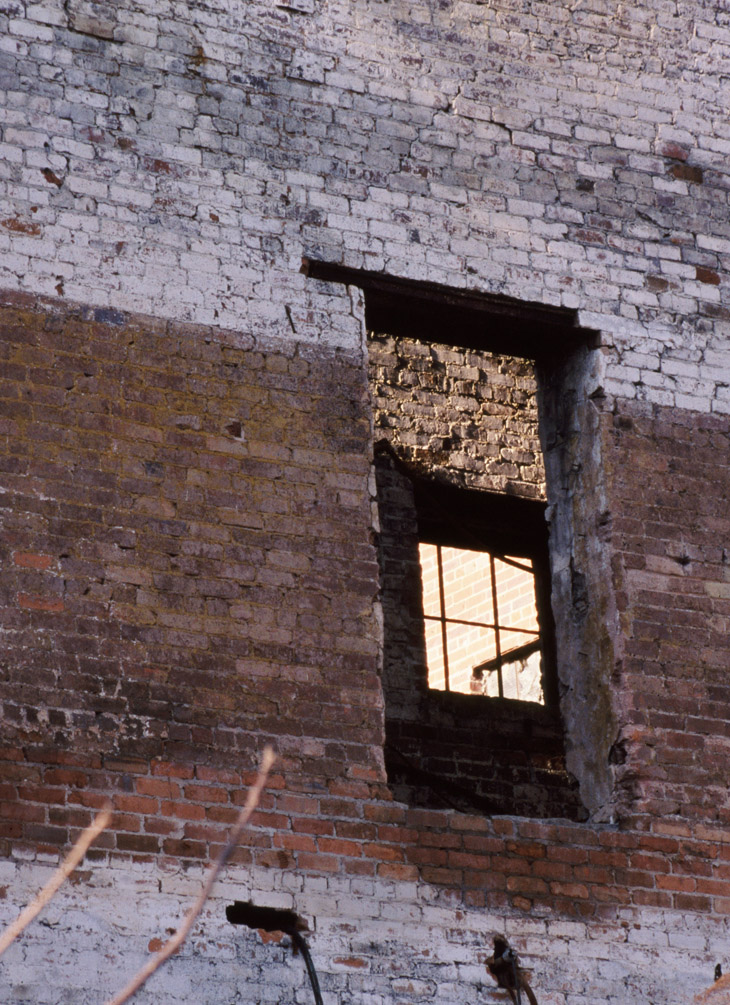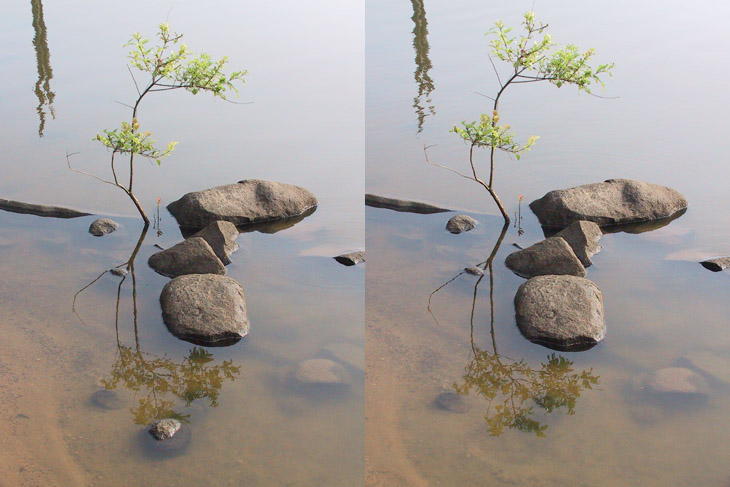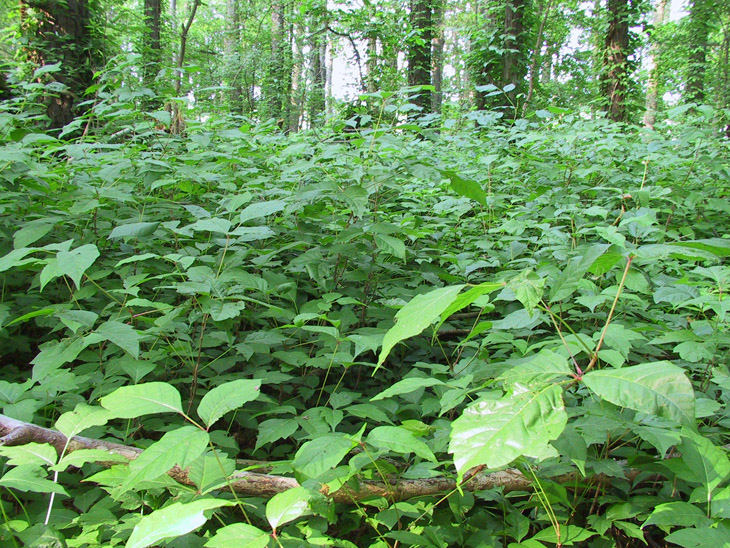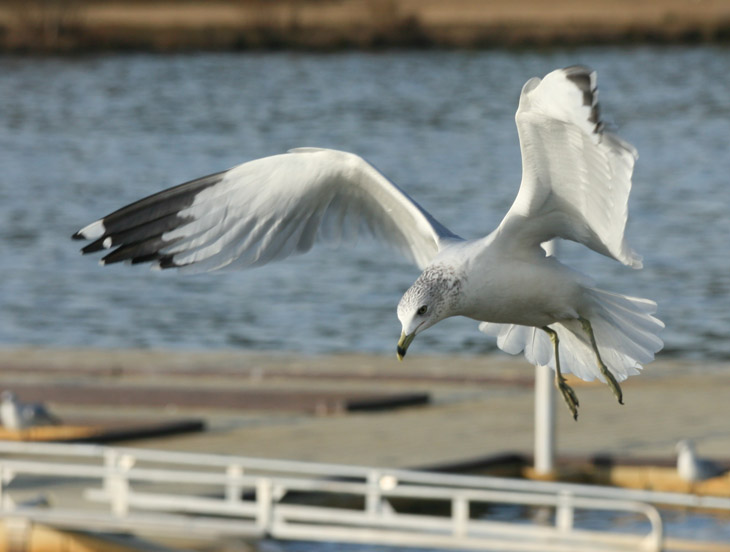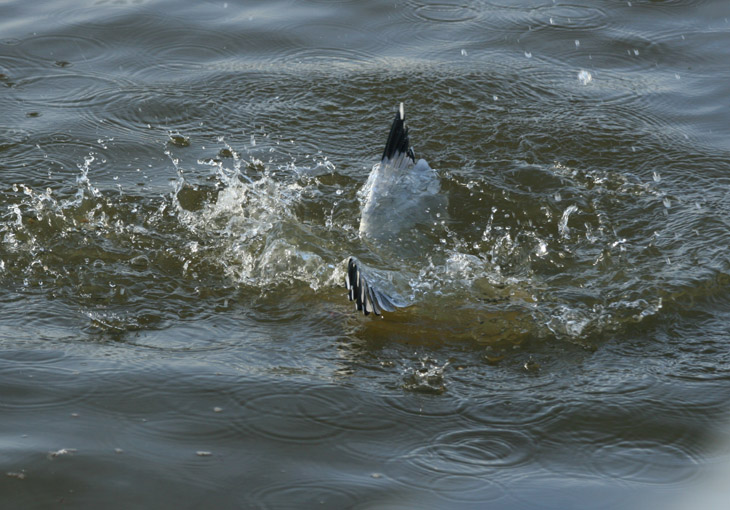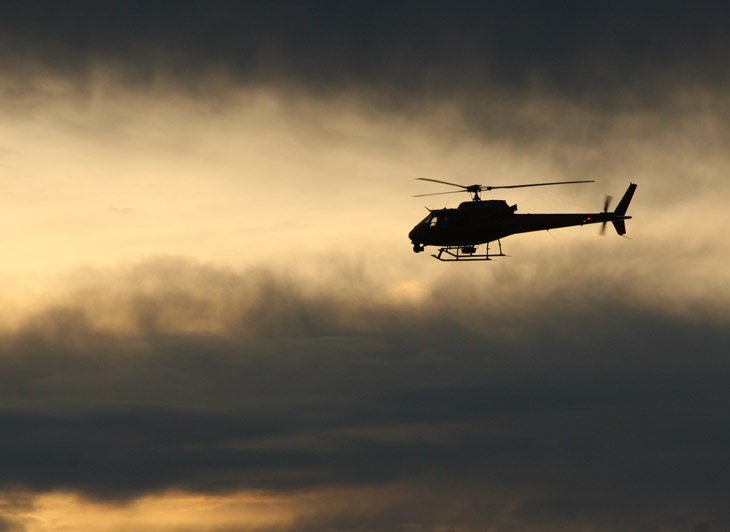Of course, with the replacement of a small stack of bound pages with kitten pictures on our walls and the practice of crossing out the incorrect date on our checks (neither of which actually occurs anymore,) it is time to examine the previous twelve months and try to figure out what went wrong, just so we can feel better about what the next twelve months might hold. And since I’m too self-absorbed to pay any attention to “world events” and nonsense like that, we’ll be doing this from the perspective of the blog itself – what else could you possibly need?
Let’s start with the ol’ tag roundup – I won’t be explaining this again, so see here or here or here if you need to, but otherwise we’ll go straight into some of the [really, there’s a] shitload of one-time-only tags that have been used. And we won’t be sticking to 2017, because reasons. I will say that the featuring of so many of Jim Kramer’s images last year produced a lot all by themselves, and if those below aren’t enough, feel free to click on the James L. Kramer tag to see even more.
more goddamn dew-covered webs – Not to be confused with more goddamn spiders in dew-covered webs. Shut up – let’s see you shoot something new and unique every. Damn. Time.
save a spot on the wall anyway – One day. One day.
you shouldn’t buy any of this except for the names – I’ve been called all of them – Granted, most of them were from my school days, but it’s the only part that’s not a lie.
etiquette demands smaller trees always go to the left – Also, “only dumbasses make that mistake.” A little guide for your composition.
interfering with the natural order in heinous ways – I’m sure someone out there is in total agreement.
Mongolian Cluster Fuck – Also, “seriously what the hell New Jersey.” Apparently I forgot I could put punctuation in tags. But check out that last illustration, at the very least.
she noticed – I’m betting it’s never been described this way before.
Look! Nipple bumps! – What? No, there’s not a theme going, piss off.
spellcheck doesn’t like “Batlizard” – Who programs these dictionaries anyway?
dammit Jim I’m a photographer not an entomologist – Also, “creepy creepy creepy.” And not that Jim – c’mon, don’t make me explain pop culture references.
Cleveland 2024: This time it’s personal – Will we fare better then? We’ll just have to see…
or maybe a bacon flute – Not even going to try to explain it.
the leaf’s even hand-painted construction paper – Shamelessly revealing a nature photography secret.
not only that but I’m a libertarian – Nobody’s even reading this, so…
leave a comment and I’ll send you a print – Safe to say I didn’t have to send out any prints. But say the magic word and maybe you’ll still get one.
The Vistas of Naughtiness – You gotta admit it has more class. Let’s start a petition.
no it’s not a stretch shut up – That one kinda ties in with…
for realsies this time – Because this really is a holiday. Not a widely accepted one, true, but it’s authentic. And then there’s…
I said on the solstice I would do this – That was this post, and I kept my promise. Though, granted, I had a tendency to forget about it, sometimes until it was technically too late. Which resulted in a rather interesting list of holidays for 2017. We had:
National Coincidence Day, February 11 National Contrition Day, February 12 National Fishing Spider Day, March 18 National Do It Thrice Day, April 30 National “What The Fuck Did I Just Eat?” Day, May 30 (which has perhaps the best blog title I’ve ever written – at least it’s vying for that spot with ‘Booger Nights‘) International Feature A Photo Series From The Previous Month Day, June 24 National Treat A Nature Photographer To Dinner Day, July 28 (yeah, thanks for that, everyone) National Miss An Astronomical Event Because of Shitty Conditions Again Day, Aug 12 (curiously, this was intended as kinda-foreshadowing of chasing the total solar eclipse later on in the month, for which I, at least, had excellent conditions.) International Dive Into a Gas Giant Day, Sept 15 National Celebrate A Holiday From Earlier In The Year Day, Sept 24 International Time Warp Day, October 6 Annual Make Up A Bogus Holiday Day, November 30 (unfortunately, I missed this one.) Kill Three Birds With One Stone Day, December 31
Naturally, you shouldn’t neglect the tags on any of those, either.
So now we’ll feature an image from each of the previous 12 months, along with my top choice post(s) from each. Of course this isn’t saying much, but hey, whaddya want? Should I pick the worst posts? Or perhaps the posts with the most egregious grammar mistakes? Hell, if I made them, I probably couldn’t spot them, so I’ll leave that one up to you…
January
We’ll go with Nothing too serious, for a couple of images from the dead season and some editing tricks on another. Which means the featured image is going to look familiar; January didn’t exactly have a busy shooting schedule. But can you find what I added into the deep fog?

February
 This month’s pick is again applicable, because it’s Podcast: What to do in the winter. And don’t ask me what kind of blossoms these are, because I don’t know, but they were at the nearby pond.
This month’s pick is again applicable, because it’s Podcast: What to do in the winter. And don’t ask me what kind of blossoms these are, because I don’t know, but they were at the nearby pond.
March
See, this is why I don’t often rate things, or pick the bestest and all that: I often find it hard to choose, or want to define criteria. So I’m going to go with I’m back baby!, but only by the tiniest margin over Friday color revisited, which probably appeals to a broader range of people because it doesn’t have a snake appearing ready to strike within it (the snake was most likely fast asleep, and anyway it’s a freaking photo so what’s the big deal?) For the feature photo, we have some double-crested cormorants wheeling overhead at sunset.
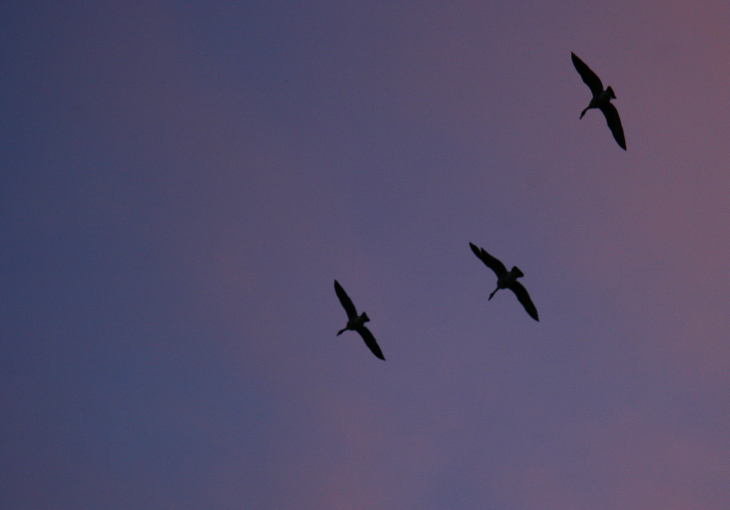
April
Hands down, the post has to be Too cool, part 35: A modicum of success, for some really close pics and even video, something I’ve been wanting to incorporate into my macro work for a while. Such examples will be increasing in number, trust me.
For the image, one that’s been sitting in the blog folder waiting for me to feature it, because from the moment I saw the scene I was thinking, “That’s one damn strong spider.”
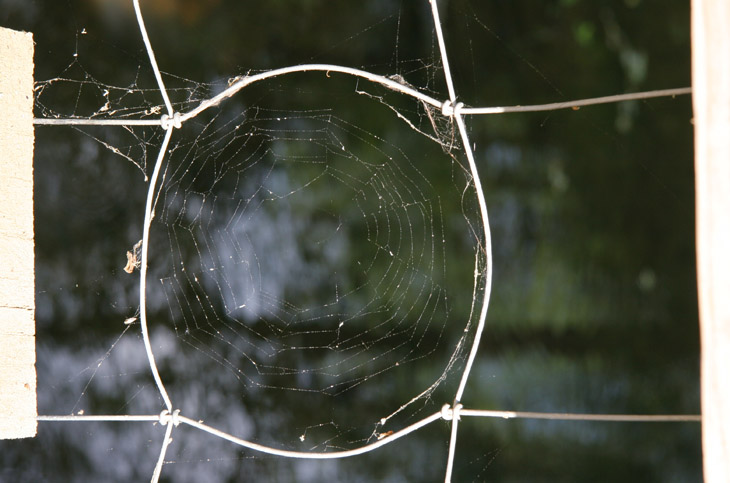
May
Another dilemma: do I feature Various and sundry, the middle entry of three regarding the enormously productive trip to North Topsail Beach, or do I promote Doctor Domoore for its reflections on a changing attitude towards wildlife and our considerations of it? I’ll have to get back to you on this one.
There were plenty of choices for the feature image, too, but I’m going with a pair of unidentified juvenile katydids playing peek-a-boo on a flower, one of the very few true insect images taken during that beach trip. See? I can branch out a little.
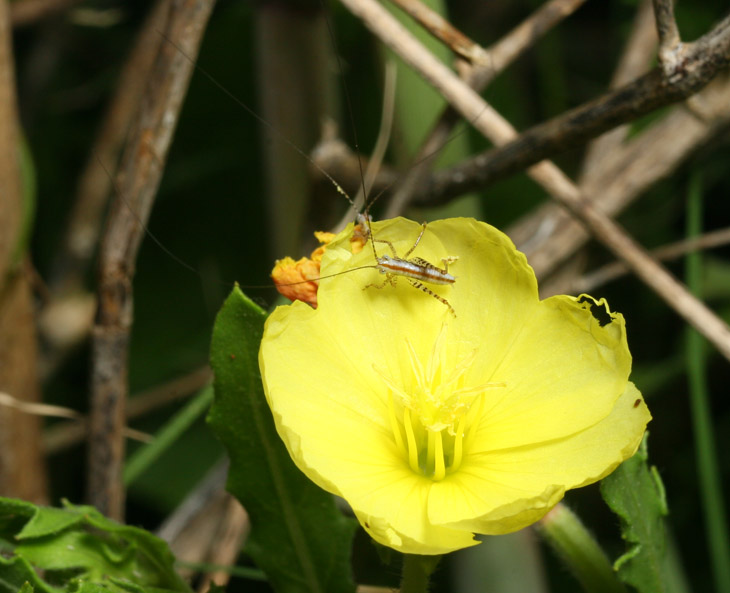
June
 Fill frogs is my choice, but the scoring system remains my secret. Meanwhile, the photo is of a juvenile black-and-yellow argiope (Argiope aurantia,) whereas an adult can be seen here. I have no photos of this one as an adult, because it disappeared soon afterward, one of the reasons the pic simply stayed in my blog folder. I’m guessing that the camouflage didn’t really work this time around.
Fill frogs is my choice, but the scoring system remains my secret. Meanwhile, the photo is of a juvenile black-and-yellow argiope (Argiope aurantia,) whereas an adult can be seen here. I have no photos of this one as an adult, because it disappeared soon afterward, one of the reasons the pic simply stayed in my blog folder. I’m guessing that the camouflage didn’t really work this time around.
July
It’ll be Eclectic and farraginous, showing astonishing breadth of subject matter – you didn’t imagine I had it in me, I know, much less such a command of vocabulary. The photo really needs no description, except for the species of dragonfly and I’m too lazy to look it up so there. And yes, those are raindrops, a brief summer shower.
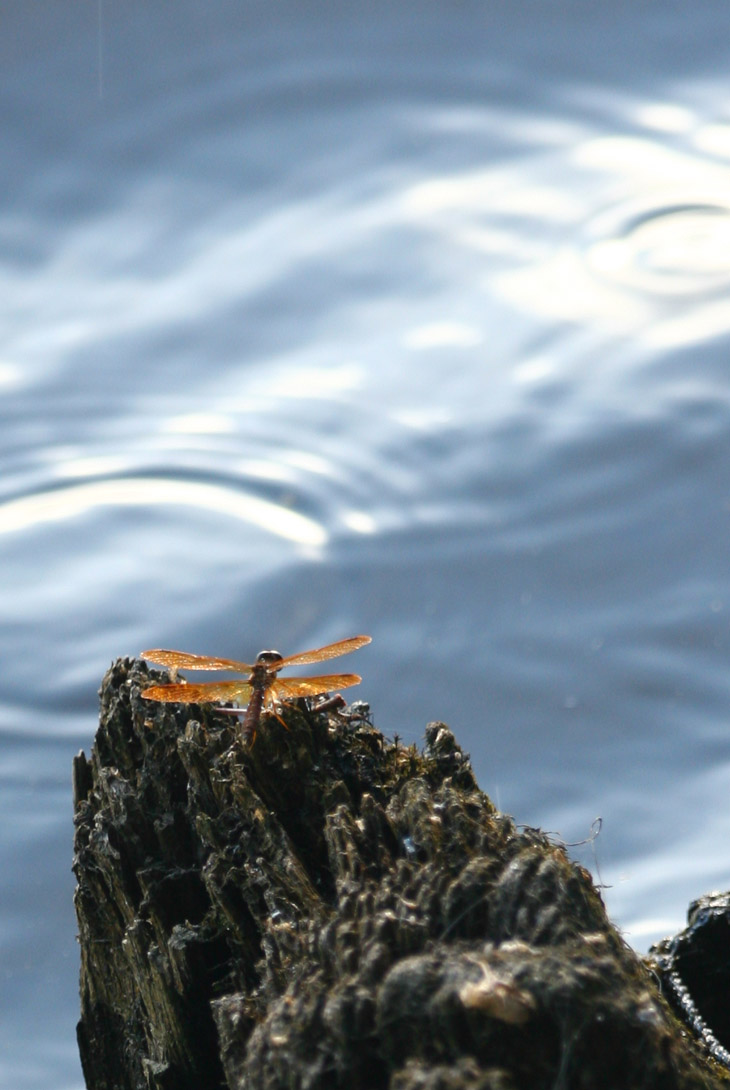
August
Flip a coin: Heads, it’s Podcast: Yeah, me too, and tails it’s About time to get out of the water. No cheating.
[“Tails,” did you catch that? Oh, the depths!]
Image-wise, we have a skipper butterfly posed fetchingly on a leaf, and if you’ve seen my cropping video you understand why it’s framed this way. You might, by some remote and freaky chance, agree.
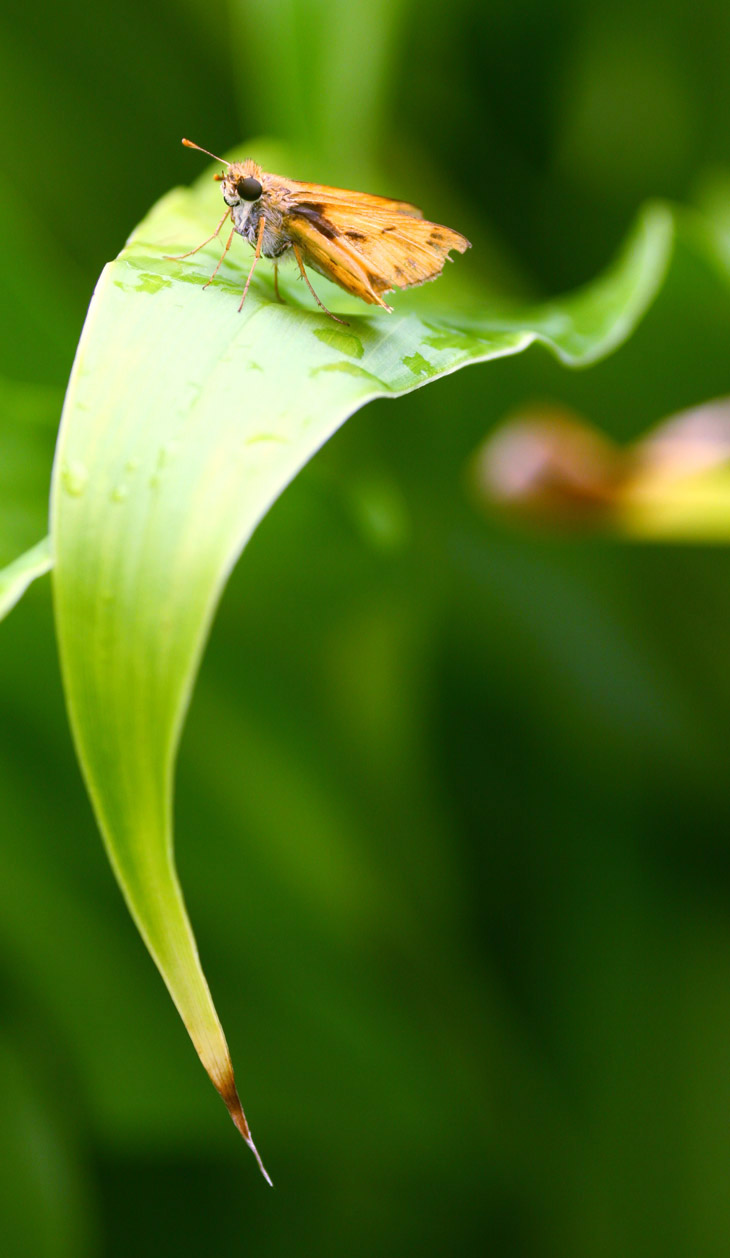
September
They are if I say so features a fine collection of strong images, and by ‘fine’ we’re talking ‘very small’ and by ‘strong’ we’re referring to things like cheese that’s been left out all week, because I’d hate for you to get the wrong impressions.
Meanwhile, a student outing netted this long-jawed orb weaver (genus Tetragnatha, and I’m leaning towards T. elongata but they’re hard to tell apart,) quite vicious-looking but very timid and very common around water sources. Their abdominal patterns can be remarkably detailed for something that relies on camouflage to avoid being eaten.
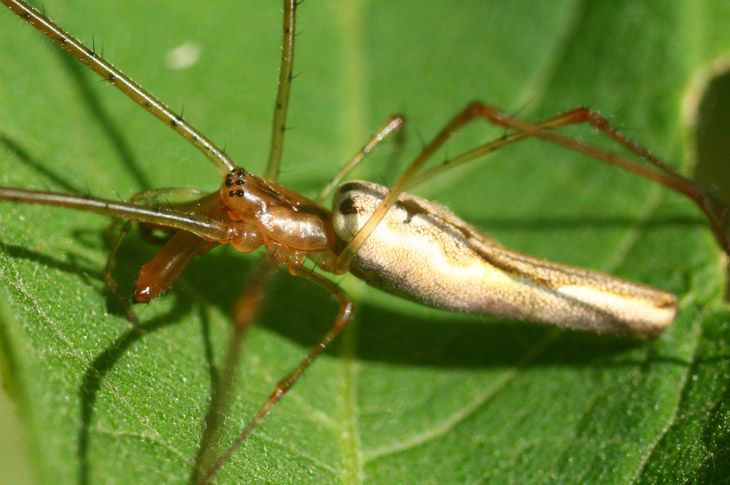
October
We’ll stick to my typical subject matter, and go with Macro photography, part 11: The lengths, the lengths, which even has a brief video clip to illustrate why you should leave this up to the professionals and pick something more relaxing, like ice-road driving. The same month featured a couple of posts on WWII aircraft, like the feature image, so perhaps you’ll want to argue my choice. Go ahead and try.

November
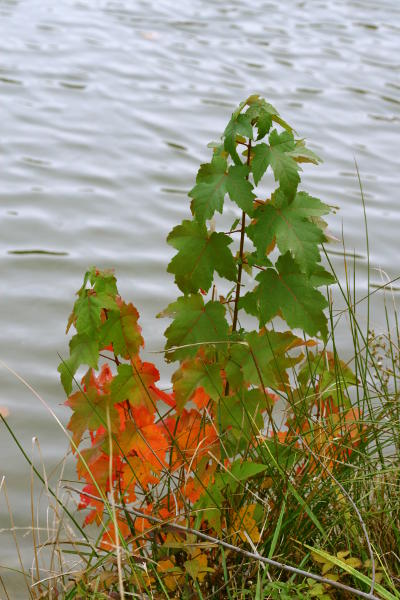 Too cool, part 36: Better than a lava lamp features a computer-generated video illustration of air currents across the hemisphere, which is fascinating, and very little input from me so there you go. And my fall shooting was extremely limited this past year but I thought this little grab shot was cool. Big fat hairy deal, I know.
Too cool, part 36: Better than a lava lamp features a computer-generated video illustration of air currents across the hemisphere, which is fascinating, and very little input from me so there you go. And my fall shooting was extremely limited this past year but I thought this little grab shot was cool. Big fat hairy deal, I know.
December
And to close off, we’ll go with a long-winded philosophical post, because there haven’t been many recently and I don’t want you to think I’m getting soft. So go read The measure of humankind cover to cover, or don’t, and try to bluff your way through an essay about it – you should know by now that never works. Yet it still might be a useful perspective on our goals so give it a shot. You can always come back and tell me I’m full of shit.
For the final image, we’ll get this closeup of a herring gull (Larus argentatus) cruising past overhead and managing not to poop on me somehow. I was shocked too.
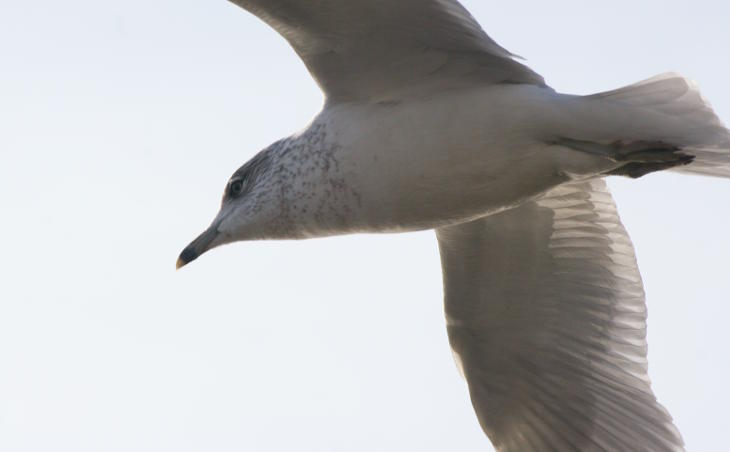
And that wraps up the year-end retrospective. Join us again next January to see what you missed by not coming here regularly. And enjoy the next year but, you know, only the next 348 days – I’m not wishing you benefits beyond that point.




















































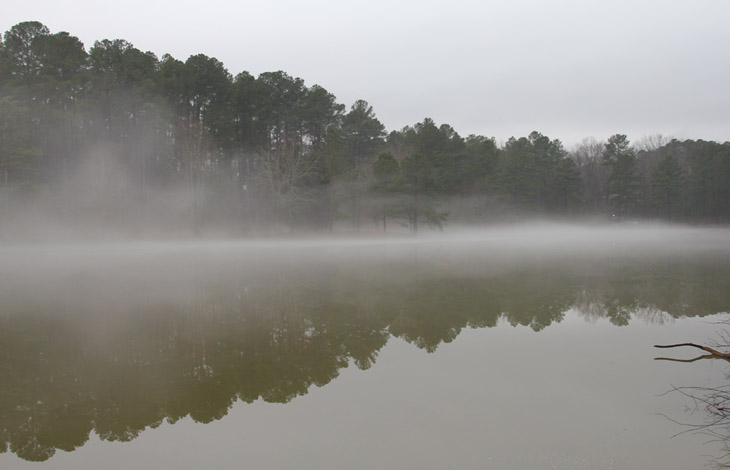
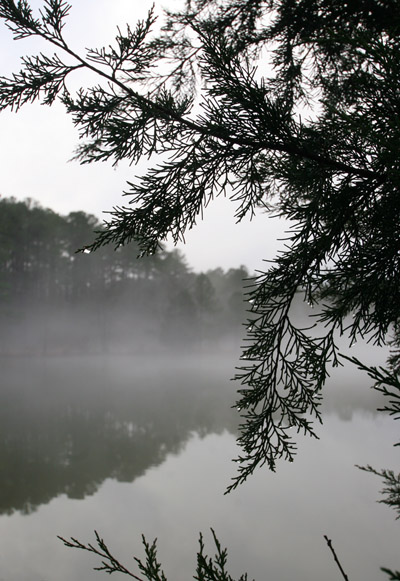 The next morning the fog came in again, so I did a little bit longer session then. The conditions were a little misty and there was even a brief and very light rain, nothing that would penetrate the camera bag much less force me back indoors, but it added some more humidity to the shots that I was taking, so, good! I won’t include a lot of exposition here, since I’m still busy with two big projects (both of which you’ll hear about when I finish them,) so I’ll throw them up here just to prove that I’m still alive, my version of holding a current newspaper I suppose. Ask you grandmother what a newspaper was…
The next morning the fog came in again, so I did a little bit longer session then. The conditions were a little misty and there was even a brief and very light rain, nothing that would penetrate the camera bag much less force me back indoors, but it added some more humidity to the shots that I was taking, so, good! I won’t include a lot of exposition here, since I’m still busy with two big projects (both of which you’ll hear about when I finish them,) so I’ll throw them up here just to prove that I’m still alive, my version of holding a current newspaper I suppose. Ask you grandmother what a newspaper was…
 I was shooting handheld with no flash in some fairly low light, so doing the extreme macro stuff was going to be difficult, but I still managed to capture a little bit of the scene in one of the hanging drops, above. I had to be very careful when doing some of these, because going in close to the subject meant a high likelihood of bumping a branch, and even if it wasn’t a branch on the same plant as the subject, the two plants might still be in contact and could thus share the vibrations, which would likely dislodge any nice hanging drops. This happened more than once, despite my efforts, so you will just have to imagine the breathtaking images that I never captured due to my clumsiness.
I was shooting handheld with no flash in some fairly low light, so doing the extreme macro stuff was going to be difficult, but I still managed to capture a little bit of the scene in one of the hanging drops, above. I had to be very careful when doing some of these, because going in close to the subject meant a high likelihood of bumping a branch, and even if it wasn’t a branch on the same plant as the subject, the two plants might still be in contact and could thus share the vibrations, which would likely dislodge any nice hanging drops. This happened more than once, despite my efforts, so you will just have to imagine the breathtaking images that I never captured due to my clumsiness.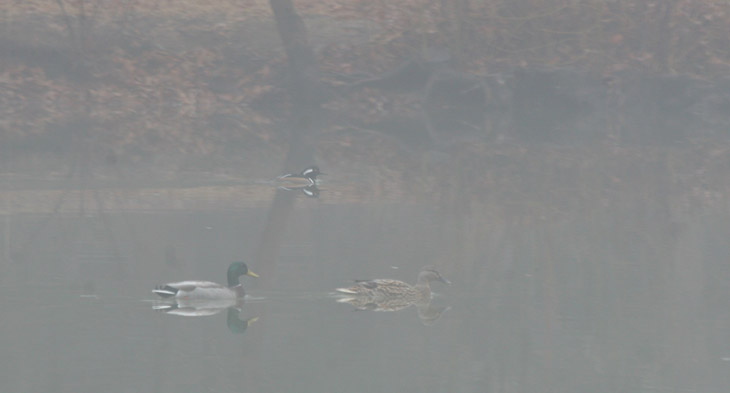
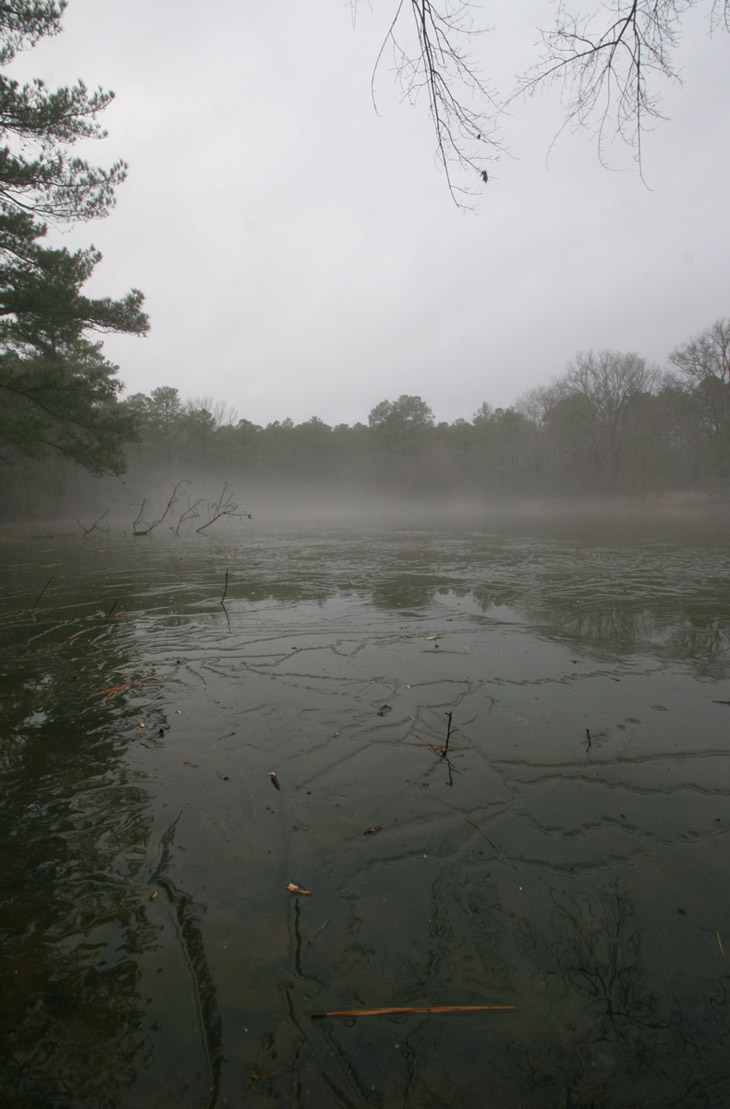
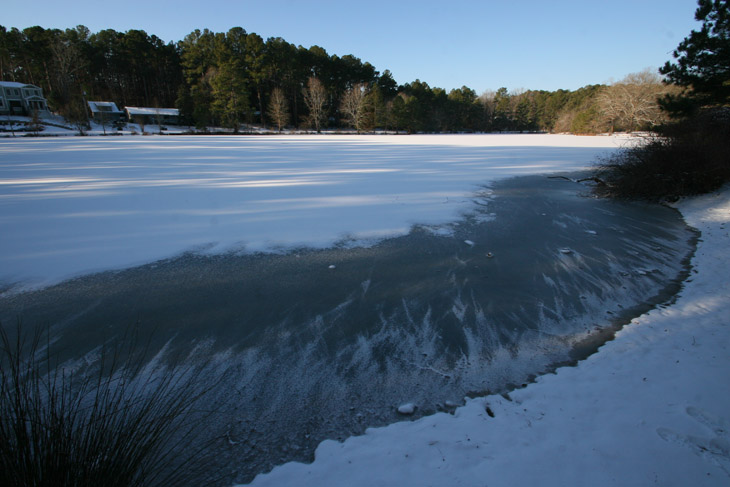
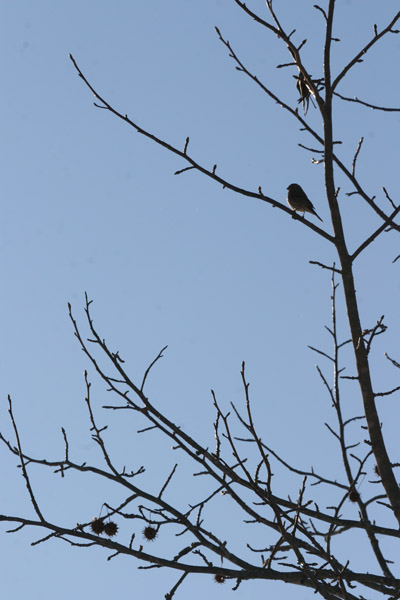 I’ve mentioned before, I’m not much of a songbird person, but there isn’t a lot else to photograph right now, and they were notably active around the pond. Most of them were reluctant to let me approach very closely, but I took what opportunities I could. Most of them were also trying their damnedest to remain within the thicket of branches at every opportunity, so nice portraits were difficult to obtain.
I’ve mentioned before, I’m not much of a songbird person, but there isn’t a lot else to photograph right now, and they were notably active around the pond. Most of them were reluctant to let me approach very closely, but I took what opportunities I could. Most of them were also trying their damnedest to remain within the thicket of branches at every opportunity, so nice portraits were difficult to obtain. 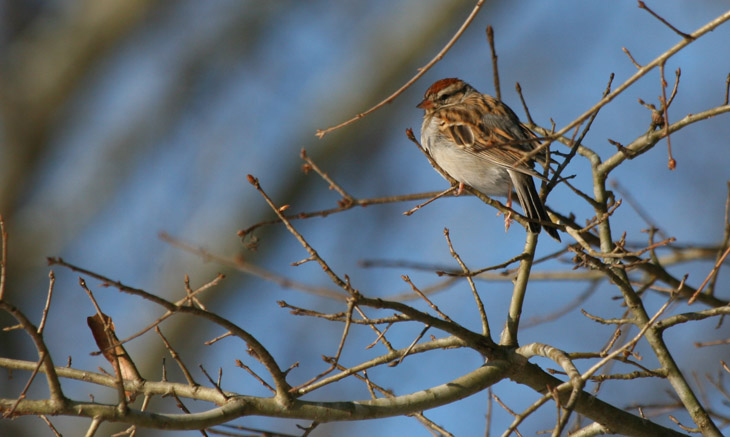
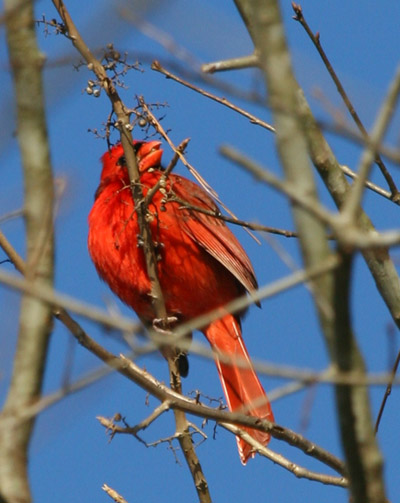 Meanwhile, this Northern cardinal (Cardinalis cardinalis) absolutely refused to adopt a striking pose or even peek out from behind the branches, but it wasn’t until I downloaded the pics and had a nice close look that I realized this was because it was feeding on some diminutive unidentified berries. Like I said, the patches of snow on branches were virtually gone, so no opportunity for a nice composition with the red cardinal, blue sky, white snow, and perhaps deep green pine needles (about the only use they can be put to.) But at least the light angle was decent. That’s not really enough to save the image, is it? Fine – be that way.
Meanwhile, this Northern cardinal (Cardinalis cardinalis) absolutely refused to adopt a striking pose or even peek out from behind the branches, but it wasn’t until I downloaded the pics and had a nice close look that I realized this was because it was feeding on some diminutive unidentified berries. Like I said, the patches of snow on branches were virtually gone, so no opportunity for a nice composition with the red cardinal, blue sky, white snow, and perhaps deep green pine needles (about the only use they can be put to.) But at least the light angle was decent. That’s not really enough to save the image, is it? Fine – be that way.
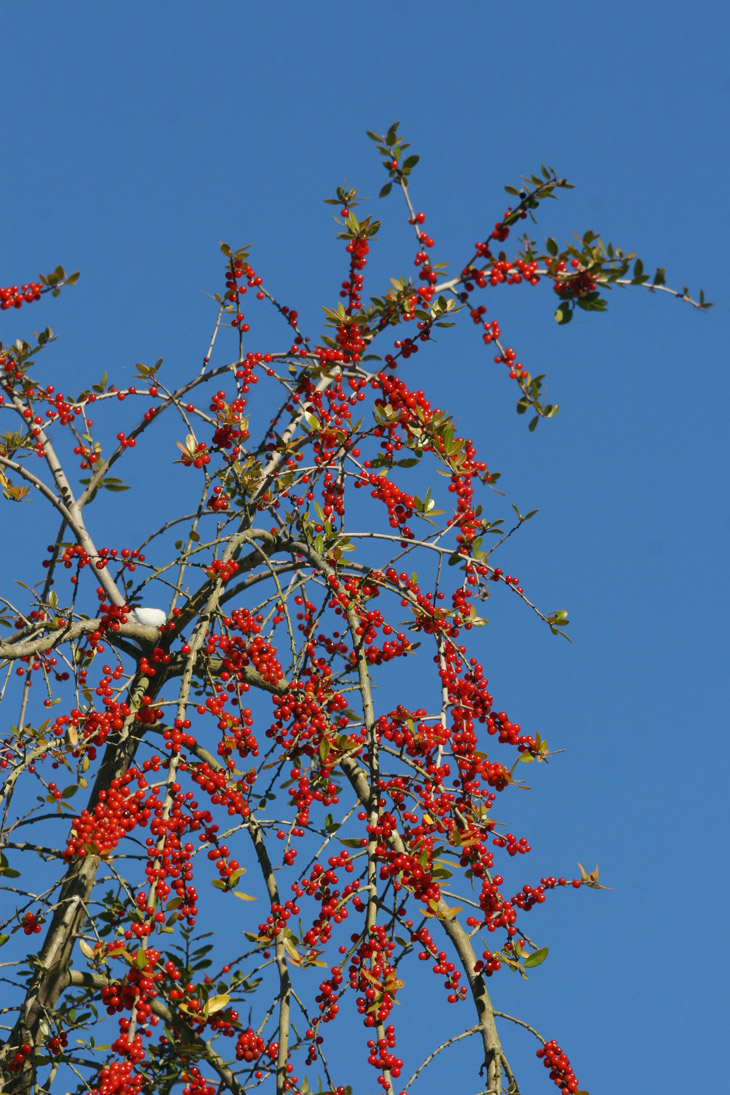
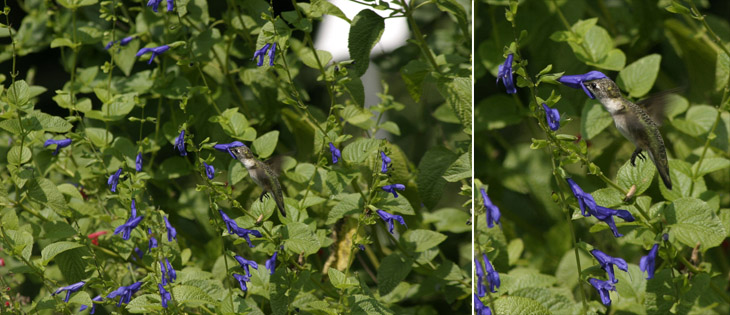


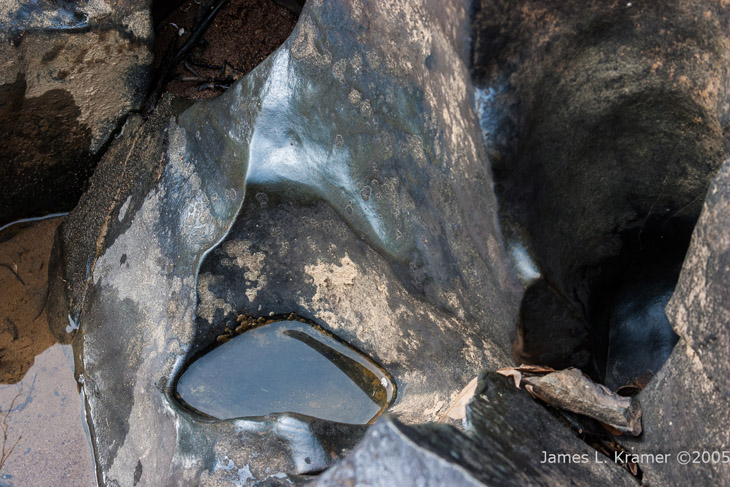
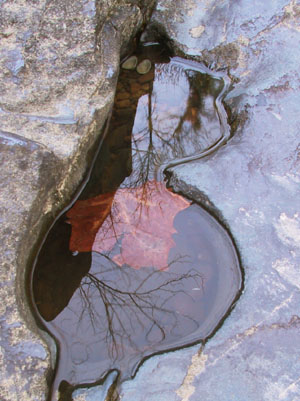 One of the more notable traits of some of the rocks in the river, southeast of the bridge, was their curious nature: sharp-edged and quite hard, apparently, but seemingly shaped by the water with some very fluid curves to them. I remember (or not) being suspicious of their shapes, not really believing the water had done that, yet not being sure what was responsible for it. But while there, I got the fartistic image (I believe) at right that I’ve used here before. And I’m almost positive that the very spot was virtually right behind me in the pic below that Jim took without my express permission or knowledge. I’m pretty sure that the camera (a Canon Pro 90 IS, my first digital) is braced against my knee for a slow exposure to capture the running water, and is one of at least two bodies that I had with me, another being the Elan IIe loaded with monochrome film. I would have believed that I had one more with me, the EOS 3 loaded with slide film, but of course that’s a huge question now isn’t it?
One of the more notable traits of some of the rocks in the river, southeast of the bridge, was their curious nature: sharp-edged and quite hard, apparently, but seemingly shaped by the water with some very fluid curves to them. I remember (or not) being suspicious of their shapes, not really believing the water had done that, yet not being sure what was responsible for it. But while there, I got the fartistic image (I believe) at right that I’ve used here before. And I’m almost positive that the very spot was virtually right behind me in the pic below that Jim took without my express permission or knowledge. I’m pretty sure that the camera (a Canon Pro 90 IS, my first digital) is braced against my knee for a slow exposure to capture the running water, and is one of at least two bodies that I had with me, another being the Elan IIe loaded with monochrome film. I would have believed that I had one more with me, the EOS 3 loaded with slide film, but of course that’s a huge question now isn’t it?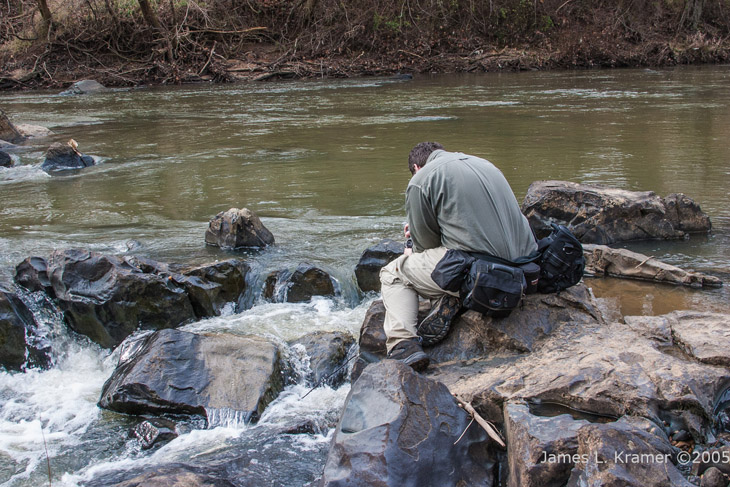
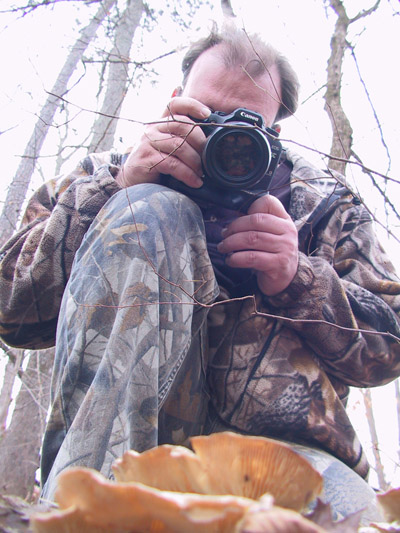 I could recognize the viewfinder of the Pro 90 IS in the image above, but also have the photo at left of Jim himself taken during that outing, where I used the flip-out LCD panel to do a very low angle shot from beneath a mushroom, aiming up at Jim. Whether he actually snapped a frame during this time or just posed obligingly I’m not sure, naturally. I am, in fact, including this photo just to get back at Jim a little bit because of what he did to me here. Ha! Didn’t remember me taking this photo, did you Jim? Ha!
I could recognize the viewfinder of the Pro 90 IS in the image above, but also have the photo at left of Jim himself taken during that outing, where I used the flip-out LCD panel to do a very low angle shot from beneath a mushroom, aiming up at Jim. Whether he actually snapped a frame during this time or just posed obligingly I’m not sure, naturally. I am, in fact, including this photo just to get back at Jim a little bit because of what he did to me here. Ha! Didn’t remember me taking this photo, did you Jim? Ha!